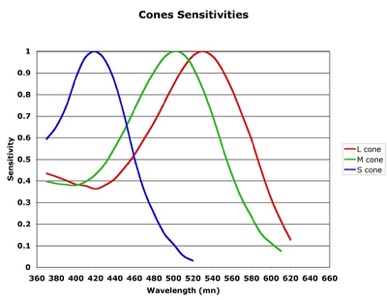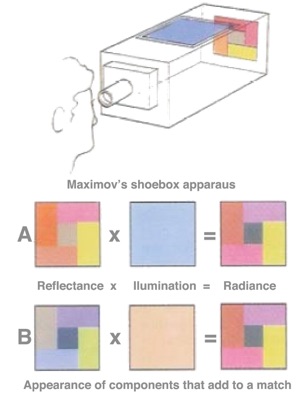Color Constancy


Departures from perfect constancy are the signatures of the underlying constancy mechanism.
Do Humans “Discount the Illuminant”?
J. J. McCann, “Do humans discount the illuminant?”,
In Proc. SPIE Vol. 5666, Human Vision and Electronic Imaging X; B. E. Rogowitz, T. N. Pappas, S. J. Daly; Eds., San Jose, p. 9-16, 2005.
In constancy experiments, humans report very small changes in appearance with substantial illumination changes. Hermann von Helmholtz introduced the term “discounting the illuminant” to describe 19th century thinking about underlying mechanisms of constancy. It uses an indirect approach. Since observers see objects as constant, observers “must” be able to detect the spatial and spectral changes in illumination and automatically compensate by altering the signals from the quanta catches of retinal receptors. Instead of solving the problem directly by calculating an object’s reflectance from the array of scene radiances, Helmholtz chose to solve the problem of identifying the illumination. Twentieth century experiments by Hubel and Wiesel, Campbell, Land, and Gibson demonstrate the power of mechanisms using spatial comparisons. This paper analyses a series of different experiments looking for unequivocal evidence that either supports “discounting the illuminant” or supports spatial comparisons as the underlying mechanism of constancy.
Mechanism of Color Constancy
J. J. McCann, “Mechanism of Color Constancy”, Proc. IS&T/SID Color Imaging Conference, IS&T/SID, Scottsdale, Arizona, 12, 29-36, 2004
Abstract
There are two widely held theories of color constancy based on very different mechanisms: Chromatic Adaptation and Spatial Comparisons. Chromatic Adaptation is based on the change of retinal sensitivity in response to changes in incident light. The Spatial Comparisons mechanism is insensitive to illumination changes because it uses ratios of radiance from different pixels in the image. A spatially uniform increase in long-wave light increases both the numerator and the denominator by the same factor, so that the ratio remains constant.
Spatial Comparisons of all pixels in the image synthesize a constant image, when the long-, middle-, and short-wave images are processed independently. Measurements of color appearance in constancy experiments have shown that there are small consistent departures from perfect constancy. This paper measures the color and magnitude of these departures from perfect color constancy. It tests the hypothesis that these departures provide a signature of the underlying constancy mechanism. Since Chromatic Adaptation mechanism is specific for illumination, then these departures are predicted to be the same, regardless of the color of the paper. Since the Spatial Comparisons mechanism is based on the Integrated Reflectance of the paper, gray papers should show greater constancy than colored papers. In other words, the signature of Chromatic Adaptation is constant departures for each illumination, while the signature of Spatial Comparisons is variable departures for each reflectance. This paper measures the color matches for a yellow, a purple and a gray paper in 27 different illuminants.
Displays that shut off constancy
Rules for colour constancy
J. J. McCann, “ Rules for colour constancy”
Ophthal. Physiol. Opt., 1992, Vol. 12, April 175
Abstract
Colours of objects tend to be constant regardless of the colour of the illuminant, therefore, regardless of the quanta catch of the retinal cones. Various mechanisms for this including context recognition, adaptation of retinal sensitivities and independent processing by receptor types have been proposed. These present experiments test the hypothesis that colours are determined by the normalized relationship between all colours in the field of view. In this hypothesis, colours are constant in classical experiments simply because changes of the illuminant do not disrupt the relationship between quanta catches across the field of view. The experiments consist of making sets of colour displays; each with the same relative quanta catches, but different absolute reflectances. 'Colour tatami' arrays of five colour patches were printed using controlled amounts of yellow, magenta, cyan and black toners. The experiment began with a control 'colour tatami' array of reflectances with measured relative quanta catches. New arrays of colours were then chosen that increased (or decreased) the reflectances, and quanta catches, a constant amount for the entire array. These changes were done independently for each receptor type. When these 'colour tatami' are viewed in the room, each array has a different set of colours. When viewed in a restricted field of view, all arrays appear the same. In a further experiment new areas such as white are added to the display. Colour constancy is a field phenomenon controlled by the relative quanta catches in the field of view. Absolute colour constancy is controlled by the relative quanta catches in the field of view and the absolute quantum catches of the receptor.
Displays that shut off Color Constancy
Human color constancy has limits. Under the right conditions, colored papers change their appearance. These studies measure the limits of constancy.
These experiments show that independent L-, M-, and S-wave spatial comparison normalize color appearances.
Does Constancy discount the illumination, or calculate reflectances?
Helmholtz proposed that humans have the ability to determine the spectral characteristics of the illumination. If humans “know” each scene’s illumination, then they can calculate each object’s reflectances by dividing the receptor’s quanta catch by the known illumination. Helmholtz never described how humans “know” illumination. He just said we discount it.
If humans “know” illumination, and if they use this information to achieve color constancy, then changes in color appearances in constancy experiments should correlate with changes in illumination.
Experiments using 27 illuminants show that the departures from perfect constancy do not correlate with illumination changes. Additionally, these constancy departure do correlate with crosstalk from cone spectral sensitivities. This adds additional evidence that constancy uses spatial comparison mechanisms.
________________________
In summary, the above experiments show that human color constancy depends on spatial comparisons. Pixel based mechanism, including chromatic adaptation cannot account for the color matching data.
Color Mondrians
This study is the original quantitative measurement of color constancy by McCann McKee and Taylor (MMT).
This paper describes both: experiments measuring observer matches, and a bottom-up model using spatial-comparisons predicting the observer matches.
Color Constancy became a critical measure of the quality of models of human vision in the second half of the nineteenth century. Helmholtz, as the champion of Thomas Young trichromacy and J.C. Maxwell’s colorimetry, described a bottom-up model of retinal response.
Nevertheless, color constancy presented strong evidence that quanta catch at a pixel was irrelevant to color appearance. Helmholtz’s response was to introduce the concept of “discounting the illuminant”. He did not describe the mechanism that could discount illumination.
This website is a collection of experimental studies measuring color matches in color constancy experiments.

Color Mondrians with constant Adaptation
MMT showed that a spatial color synthesis mechanism can accounts for constancy.
Are there other viable constancy mechanisms?
For example, chromatic adaptation has been proposed as mechanism for constancy. The average quanta caught by visual receptors will set the eyes’ adaptation state. Adaptation mechanisms respond to average quanta caught. These experiments control the average quanta in the test targets. They looked for correlation between quanta catch and appearance. No correlation was found.



